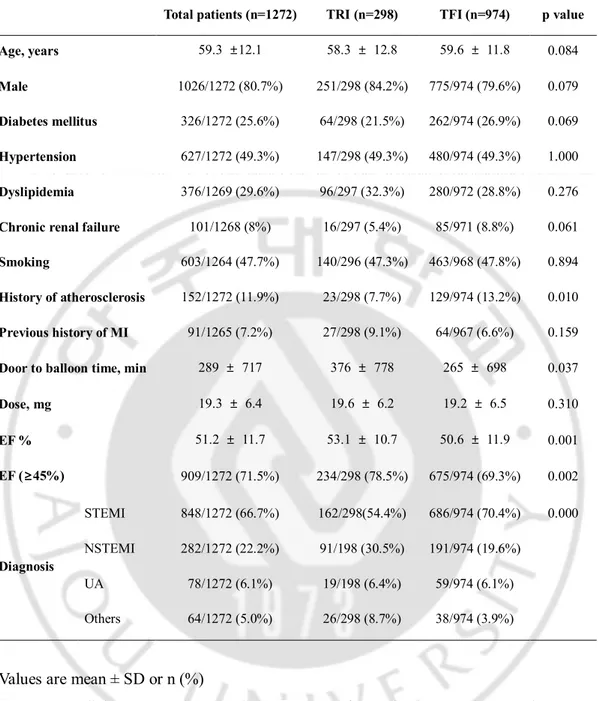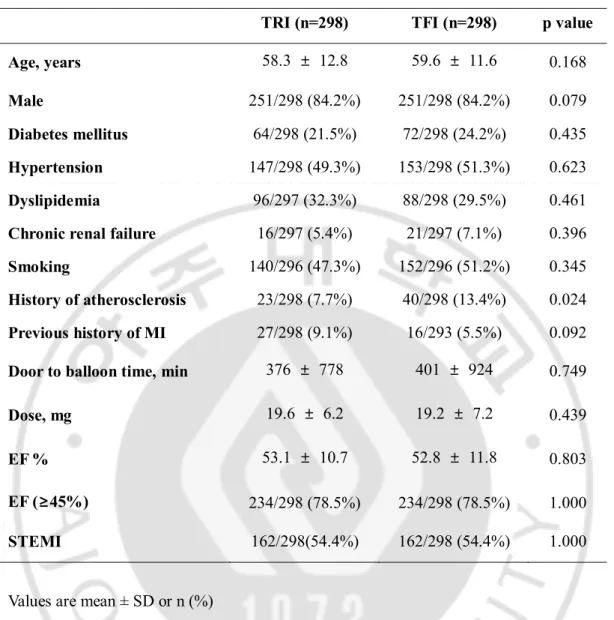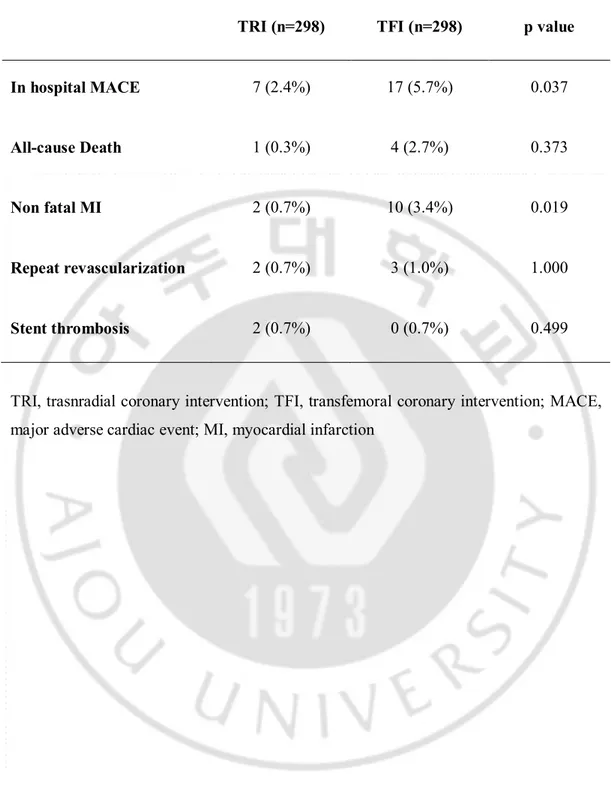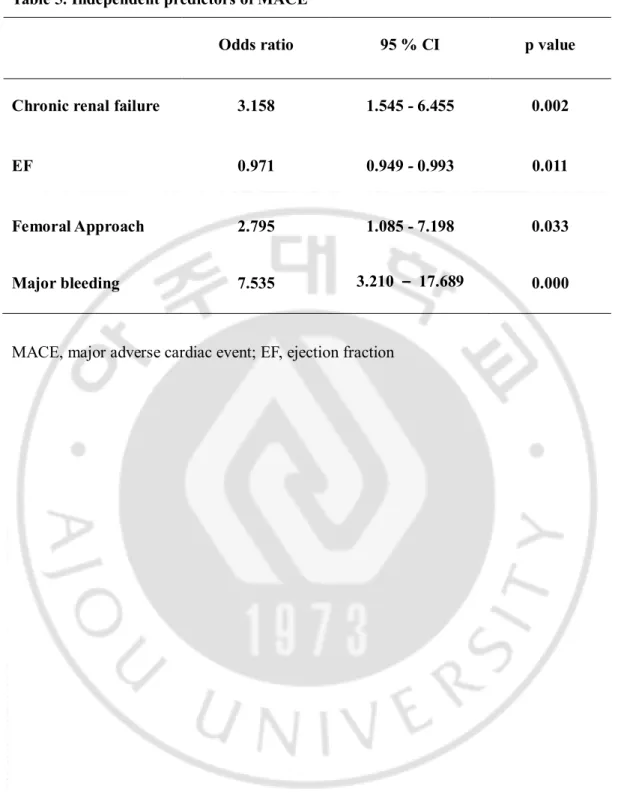저작자표시-비영리-변경금지 2.0 대한민국 이용자는 아래의 조건을 따르는 경우에 한하여 자유롭게 l 이 저작물을 복제, 배포, 전송, 전시, 공연 및 방송할 수 있습니다. 다음과 같은 조건을 따라야 합니다: l 귀하는, 이 저작물의 재이용이나 배포의 경우, 이 저작물에 적용된 이용허락조건 을 명확하게 나타내어야 합니다. l 저작권자로부터 별도의 허가를 받으면 이러한 조건들은 적용되지 않습니다. 저작권법에 따른 이용자의 권리는 위의 내용에 의하여 영향을 받지 않습니다. 이것은 이용허락규약(Legal Code)을 이해하기 쉽게 요약한 것입니다. Disclaimer 저작자표시. 귀하는 원저작자를 표시하여야 합니다. 비영리. 귀하는 이 저작물을 영리 목적으로 이용할 수 없습니다. 변경금지. 귀하는 이 저작물을 개작, 변형 또는 가공할 수 없습니다.
i
Impact of Transradial Approach in Patients with High Risk Acute
Coronary Syndrome Undergoing Percutaneous Coronary
Intervention and Abciximab on In-Hospital Clinical Outcomes
and Bleeding Complications
by
Yong Woo Choi
Major in Medicine
Department of Medical Science
The Graduate School, Ajou University
ii
Impact of Transradial Approach in Patients with High Risk Acute
Coronary Syndrome Undergoing Percutaneous Coronary
Intervention and Abciximab on In-Hospital Clinical Outcomes
and Bleeding Complications
: A Propensity Score-Matched Analysis from Clotinab Application
in High Risk Acute Coronary Syndrome
Undergoing PCI Registry
by
Yong Woo Choi
A Dissertation Submitted to The Graduate School of Ajou
University in Partial fulfillment of The Requirements for
The Degree of Master of Medicine
Supervised by
Seung Jea Tahk, M.D., Ph.D.
Major in Medicine
Department of Medical Science
The Graduate School, Ajou University
iii
This certifies that the dissertation
Of Yong Woo Choi is approved
.
SUPERVISORY COMMITTEE
Seung Jea Tahk
Seung Jea Tahk
Joon Han Shin
Joon Han Shin
Gyo Seung Hwang
Gyo Seung Hwang
So Yeon Choi
So Yeon Choi
The Graduate School, Ajou University
December 13th, 2013
i
-ABSTRACT -
Impact of Transradial Approach in Patients with High Risk Acute
Coronary Syndrome Undergoing Percutaneous Coronary
Intervention and Abciximab on In-Hospital Clinical Outcomes
and Bleeding Complications
: A Propensity Score-Matched Analysis from Clotinab Application
in High Risk Acute Coronary Syndrome Undergoing PCI
Registry
Backgrounds: There are increasing numbers of studies suggesting that transradial coronary intervention (TRI) is associated with better clinical outcomes by reducing bleeding and vascular complications when compared with transfemoral coronary intervention (TFI). The benefit of TRI might be enlarged in patients at high risk of bleeding. The purpose of this study was to evaluate clinical outcomes comparing transradial and transfemoral approaches in the treatment of high risk acute coronary syndrome undergoing percutaneous coronary intervention (PCI) with the GP IIb/IIIa inhibitor from Clotinab application in high risk Acute Coronary Syndrome undergoing PCI Registry (CAP Registry)
Methods: The CAP registry is a retrospective, multicenter, observational study. We analyzed 1272 patients who underwent PCI from April 2009 to December 2012. Because the access site was not randomly assigned, we used propensity score matching to
minimize bias. Total 596 patients (298 in each group) remained after propensity score matching. The primary end point was in-hospital major adverse cardiac event (MACE) including all-cause death, non-fatal myocardial infarction, repeat revascularization and stent thrombosis. The secondary endpoint was major bleeding and any bleeding events of bleeding including access site hematoma, intracranial hemorrhage and other bleeding complications.
ii
characteristics between two groups except history of atherosclerosis (7.7% vs. 13.4%, p=0.024). The primary endpoint occurred in 7 (2.4%) of 298 patients in the radial access group compared with 17 (5.7%) of 298 patients in the femoral access group (p=0.037). Non-fatal myocardial infarction (0.7% vs. 3.4%, p=0.019) were also less frequent in transradial approach group. Any bleeding events occurred in 15 (5.0%) of 298 patients in the radial access group compared with 21 (7.0%) of 298 patients in the femoral access group (p=0.302). Major bleeding occurred in 2 (0.7%) of 298 patients in the radial access group compared with 7 (2.3%) of 298 patients in the femoral access group (p=0.093). In multivariate analysis, independent predictors of in-hospital MACE included chronic renal failure, low ejection fraction, major bleeding and transfemoral approach (odds ratio=2.795 ; 95% CI, 1.085 to 7.198; P=0.033).
Conclusions: Transradial approach in patient with high risk acute coronary syndrome treated with abciximab is associated with better in-hospital clinical outcomes and lower bleeding tendency.
Key words: percutaneous coronary intervention, abciximab, acute coronary syndrome, myocardial infarction
iii
TABLE OF CONTENTS
ABSTRACT···i
TABLE OF CONTENTS ··· iii
LISTOF TABLES ··· iv
I.INTRODUCTION···1
II. METHODS ···2
A. Study population···2
B.Study outcomes··· 2
C. Propensity matching and statistical analysis··· 3
III.RESULTS··· 4
IV. DISCUSSION··· 11
V.CONCLUSION··· 13
REFERENCES··· 14
iv
LIST OF TABLES
Table 1. Baseline characteristics before propensity matching··· 6
Table2. Baseline characteristics after propensity matching···7
Table 3. Clinical outcomes after propensity matching··· 8
Table 4. Bleeding complications after propensity matching··· 9
1
I. Introduction
Glycoprotein IIb/IIIa inhibitors (GPI) selectively block the glycoprotein IIb/IIIa
(GPIIb/IIIa) receptor on the surface of the platelet preventing the binding of fibrinogen to the receptor. The first agent in this class that was introduced to clinical practice and the most widely studied was abciximab; it competitively binds to the GPIIb/IIIa receptor and prevent binding of fibrinogen and von Willebrand factor to activated platelets, and therefore blocks the final common pathway for platelet aggregation while adhesion and secretion are preserved (Mascelli et al., 1998; Romagnoli et al., 2007).
While, abciximab has the potential to increase the risk of bleeding. Many abciximab-treated patients with major bleeding had bleeding at the arterial access site in the groin. Abciximab-treated patients also had a higher incidence of major bleeding events from gastrointestinal, genitourinary, retroperitoneal, and other sites. The recent European Society of Cardiology guidelines for the Management of acute myocardial infarction in patients presenting with ST-segment elevation state that GPI should be considered for bailout therapy if there is angiographic evidence of massive thrombus and in the presence of slow/no-reflow or thrombotic complications (Class 2a, level C); furthermore upstream use of GPI may be considered in high risk patients (Class 2b, level B).
First described several decades ago(Campeau, 1989), transradial coroanry intervention (TRI) has evolved into a viable alternative to the traditional femoral intervention (TFI).There are increasing amount of data suggesting that TRI is associated with better clinical outcomes by reducing bleeding and vascular complications when compared with procedures carried out through the femoral artery(Kiemeneij et al., 1997; Mann et al., 1998; Chodor et al., 2009; Hetherington et al., 2009; Ruzsa et al., 2009; Vorobcsuk et al., 2009). The benefit of TRI might be enlarged in patients at high risk of bleeding. The purpose of this study was to evaluate clinical outcomes comparing transradial and transfemoral approaches in the treatment of high risk acute coronary syndrome
undergoing percutaneous coronary intervention (PCI) with the GP IIb/IIIa inhibitor from Clotinab○R(Isuabxis, Seongnam, Gyeonggi-do Korea) application in high risk Acute Coronary Syndrome undergoing PCI Registry (CAP Registry).
2
II. Methods
A. Study population
The CAP registry is a retrospective, multicenter, observational study of 28 hospitals in Korea. Data on high risk acute coronary syndrome patients for PCI were collected. We analyzed 1272 patients who underwent PCI and received abciximab at any time of PCI procedure from April 2009 to December 2012. Study was registered at
www.ecrf.kr/clotinab. These patients were divided into two groups, those who had their PCI performed from radial approach and those who were treated with transfemoral approach. Because the access site was not randomly assigned, we used propensity score matching to minimize bias. Total 596 patients (298 in each group) remained after propensity score matching. Loading dose of abciximab was 0.25 mg/kg, and maintain dose was 0.125 ug/kg/min for 12 hours. Loading of abciximab was injected by intracoronary or intravenous route.
Access site hematoma was recognized if it appeared during hospitalization at the arterial access site and its recognition was at the investigator’s discretion. Major bleeding was defined as intracranial bleeding or decrease of hemoglobin over 5 g/dL during
hospitalization.
Exclusion criteria were patients with age over 80 years, bleeding diathesis, history of clinically significant gastrointestinal bleeding or genitourinary bleeding within 6 weeks, platelet counts under 100,000/uL, major operation within 6 weeks, severe uncontrolled hypertension, and severe hepatic (serum albumin < 2.5 g/dL) or renal dysfunction (serum Cr > 2.5 mg/dL).
All patients were pre treated with loading dose of aspirin, clopidogrel, and unfractionated heparin.
B. Study outcomes
The primary end point was in-hospital major adverse cardiac event (MACE) including all-cause death, non-fatal myocardial infarction, repeat revascularization and stent thrombosis. The secondary endpoints were major bleeding and any bleeding events
3
including access site hematoma, intracranial hemorrhage and other bleeding complications.
C. Propensity matching and statistical analysis
Univariate comparisons between TRI and TFI were conducted using t tests. Relationship with categoric variates were evaluated using ϰ2 tests.
Because of selection bias in assignment of patients to approach types, bias reduction technique was used to allow testing of the relative effect of TRI on bleeding and clinical outcomes. A propensity scoring model was developed to summarize covariate
information regarding treatment selection (TRI or TFI) into a single scalar value (propensity score) and subsequently was used in nearest-neighbor, caliper-constrained matching technique. A total 298 matched pairs (N= 596) of TRI and TFI were identified and used for subsequent analysis.
In addition, a multivariate logistic regression analysis was carried out to determine independent factors that predict bleeding and clinical outcomes.
Statistical significance was defined as a P value less than 0.05. All analysis was conducted using SPSS software (version 18.0, Chicago, Illinois, USA).
4
III. Results
Data on 1272 patients were entered into the CAP registry. Radial site access was used in 298 (23%) patients, whereas femoral access site was used in the remaining 974 (77%) patients.
Baseline characteristicswere presented in Table 1. Patients in whom radial access was chosen had better ejection fraction (53.1% vs. 50.6%, p = 0.001) than patients in whom femoral access was chosen. and patients diagnosed with ST elevation myocardial infarction were significantly different between two groups. Door to balloon time (376 min vs. 275 min, p = 0.037) was also different due tothe different frequency of primary intervention.
After propensity score matching, there were no differences in baseline characteristics between two groups (Table 2).
There were30 cases of total mortality, but no cases were directly caused by
bleeding.After propensity score matching, the primary endpoint occurred in 7 (2.4%) of 298 patients in the radial access group compared with 17 (5.7%) of 298 patients in the femoral access group (p=0.037). Non-fatal myocardial infarction (0.7% vs. 3.4%, p=0.019) were less frequent in transradial approach group (Table 3).
Total bleeding events of 1272 patients were 8.3% (105 patients) of patients (TRI group was 5.0%, and TFI group was 9.2%). After propensity score matching, any bleeding events occurred in 15 (5.0%) of 298 patients in the radial access group compared with 21 (7.0%) of 298 patients in the femoral access group (p=0.302). Major bleeding occurred in 2 (0.7%) of 298 patients in the radial access group compared with 7 (2.3%) of 298 patients in the femoral access group (p=0.093) (Table 4).
In multivariate analysis (adjusted variables were age, sex, diabetes mellitus,
hypertension, chronic renal failure, femoral approach, major bleeding, door to balloon time, dose, ejection fraction, diagnosis), independent predictors of in-hospital MACE included chronic renal failure(odds ratio=3.158; 95% CI, 1.545 to 6.455; P=0.002), low ejection fraction(odds ratio=0.971; 95% CI, 0.949 to 0.993; P=0.011), major bleeding (odds ratio=7.535; 95% CI, 3.210 to 17.689; P=0.000) and femoral approach (odds
5
6
Table 1. Baseline characteristics before propensity matching
Total patients (n=1272) TRI (n=298) TFI (n=974) p value Age, years 59.3 ±12.1 58.3 ± 12.8 59.6 ± 11.8 0.084
Male 1026/1272 (80.7%) 251/298 (84.2%) 775/974 (79.6%) 0.079
Diabetes mellitus 326/1272 (25.6%) 64/298 (21.5%) 262/974 (26.9%) 0.069
Hypertension 627/1272 (49.3%) 147/298 (49.3%) 480/974 (49.3%) 1.000
Dyslipidemia 376/1269 (29.6%) 96/297 (32.3%) 280/972 (28.8%) 0.276
Chronic renal failure 101/1268 (8%) 16/297 (5.4%) 85/971 (8.8%) 0.061
Smoking 603/1264 (47.7%) 140/296 (47.3%) 463/968 (47.8%) 0.894
History of atherosclerosis 152/1272 (11.9%) 23/298 (7.7%) 129/974 (13.2%) 0.010
Previous history of MI 91/1265 (7.2%) 27/298 (9.1%) 64/967 (6.6%) 0.159
Door to balloon time, min 289 ± 717 376 ± 778 265 ± 698 0.037
Dose, mg 19.3 ± 6.4 19.6 ± 6.2 19.2 ± 6.5 0.310 EF % 51.2 ± 11.7 53.1 ± 10.7 50.6 ± 11.9 0.001 EF (≥45%) 909/1272 (71.5%) 234/298 (78.5%) 675/974 (69.3%) 0.002 Diagnosis STEMI 848/1272 (66.7%) 162/298(54.4%) 686/974 (70.4%) 0.000 NSTEMI 282/1272 (22.2%) 91/198 (30.5%) 191/974 (19.6%) UA 78/1272 (6.1%) 19/198 (6.4%) 59/974 (6.1%) Others 64/1272 (5.0%) 26/298 (8.7%) 38/974 (3.9%)
Values are mean ± SD or n (%)
TRI, trasnradial coronary intervention; TFI, transfemoral coronary intervention; MI, myocardial infarction; EF, ejection fraction; STEMI, ST elevation myocardial infarction; NSTEMI, Non ST elevation myocardial infarction; UA, unstable angina
7
Table 2. Baseline characteristics after propensity matching
TRI (n=298) TFI (n=298) p value
Age, years 58.3 ± 12.8 59.6 ± 11.6 0.168
Male 251/298 (84.2%) 251/298 (84.2%) 0.079
Diabetes mellitus 64/298 (21.5%) 72/298 (24.2%) 0.435
Hypertension 147/298 (49.3%) 153/298 (51.3%) 0.623
Dyslipidemia 96/297 (32.3%) 88/298 (29.5%) 0.461
Chronic renal failure 16/297 (5.4%) 21/297 (7.1%) 0.396
Smoking 140/296 (47.3%) 152/296 (51.2%) 0.345
History of atherosclerosis 23/298 (7.7%) 40/298 (13.4%) 0.024 Previous history of MI 27/298 (9.1%) 16/293 (5.5%) 0.092 Door to balloon time, min 376 ± 778 401 ± 924 0.749
Dose, mg 19.6 ± 6.2 19.2 ± 7.2 0.439
EF % 53.1 ± 10.7 52.8 ± 11.8 0.803
EF (≥45%) 234/298 (78.5%) 234/298 (78.5%) 1.000
STEMI 162/298(54.4%) 162/298 (54.4%) 1.000
Values are mean ± SD or n (%)
TRI, trasnradial coronary intervention; TFI, transfemoral coronary intervention;MI, myocardial infarction; EF, ejection fraction; STEMI, ST elevation myocardial infarction
8
Table 3. Clinical outcomes after propensity matching
TRI (n=298) TFI (n=298) p value
In hospital MACE 7 (2.4%) 17 (5.7%) 0.037
All-cause Death 1 (0.3%) 4 (2.7%) 0.373
Non fatal MI 2 (0.7%) 10 (3.4%) 0.019
Repeat revascularization 2 (0.7%) 3 (1.0%) 1.000
Stent thrombosis 2 (0.7%) 0 (0.7%) 0.499
TRI, trasnradial coronary intervention; TFI, transfemoral coronary intervention; MACE, major adverse cardiac event; MI, myocardial infarction
9
Table 4. Bleeding complications after propensity matching
TRI (n=298) TFI (n=298) p value
Any bleeding events 15 (5.0%) 21 (7.0%) 0.302
Major bleeding 2(0.7%) 7 (2.3%) 0.093
Access site hematoma 6 (2.0%) 11 (3.7%) 0.219
Intracranial bleeding 0 2 (0.7%) 0.239
Adjusted variables: Age, Sex, Diabetes mellitus, hypertension, chronic renal failure, femoral approach, major bleeding, door to balloon time, dose, ejection fraction, ST elevation myocardial infarction
10
Table 5. Independent predictors of MACE
Odds ratio 95 % CI p value
Chronic renal failure 3.158 1.545 - 6.455 0.002
EF 0.971 0.949 - 0.993 0.011
Femoral Approach 2.795 1.085 - 7.198 0.033
Major bleeding 7.535 3.210 – 17.689 0.000
11
IV. Discussion
This is the first study in which clinical outcomes and bleeding complications on abciximab were reported in patients with acute coronary syndrome undergoing PCI.
In this study, we compared transradial approach with transfemoral approach in patients treated with abciximab of high risk acute coronary syndrome. Our retrospective,
multicenter, observational study showed that TRI was associated with better in-hospital MACE and lower bleeding tendency compared with the traditional transfemoral approach.
Since the first demonstration of transradial approach feasibility by Lucien Campeau in 1989(Campeau, 1989),TRI has gained widespread acceptance. Nevertheless, a recent study reports that less than 2% of percutaneous coronary interventions were performed by a transradial approach in the United States between 2004 and 2007(Rao et al., 2008). In CAP registry, the proportion was much higher. 298 patients (23%) went through transradial approach. It was higher than previous studies (16%), such as
EUROTRANSFER registry, contemporary European registry of PCI in STEMI (Siudak et al., 2010). One of the predictors of its choice was the center experience in the radial access during PCI.
At baseline characteristics, ejection fraction and patients diagnosed with ST elevation myocardial infarction was significantly different between and TRI and TFI groups (53.1% vs. 50.6%, p = 0.001).This might mean the operators preferred TFI at clinically worse patients. Therefore, we performed propensity score matching for reducing selection bias. Door to balloon time was not significantly different between two groups after
propensity score matching. This result was similarwith the EUROTRANSFER registry (pain onset to balloon time was 225 min at TRI group, and 209 min at TFI group, p = 0.412), and single center study in Korea(Kim et al., 2005) (cath room to reperfusion time 26 min at TRI group, and 25 min at TFI, p > 0.05).
We found that in hospital major adverse cardiac events were significantly more
12
were major bleeding, femoral approach, low ejection fraction and chronic renal failure. Besides, this study showed low bleeding tendency in TRI group. As for access site hematoma, TRI group was 2.0% in this study, which is lower than the one reported by Ruzsa et al. (4%), much lower than the one reported by Chodor et al. (10%), and similar to the one reported by EUROTRANSFER registry, and the one reported by Hetherington et al. (1.8%).Considerable evidence presented that TRI has a similar procedural success and trend for reduction in ischemic events compared with those of TFI. In a recent meta-analysis,it was demonstrated that a significant benefit of using radial access for PCI in myocardial infarction with respect to major bleeding as well as in MACE(Vorobcsuk et al., 2009). Possible mechanisms of worse outcomes after a bleeding event might include bleeding-induced imbalance of the coagulant/anticoagulant mechanisms (Jolly et al., 2009). As a consequence of the more potent anticoagulant and antiplatelet medications such as abciximab, bleeding will be more frequent after acute intervention. Since bleeding has been reported to be correlated with clinical outcomes in TFI(Doyle et al., 2008), reduction of bleeding in TRI could contribute to improvement of clinical outcomes, especially in high risk abciximab-treated patients.
But, any bleeding events and major bleeding were not significant different between TRI and TFI groups. Closer device at TFI might contribute the reduction of bleeding in TFI.
In this study, we have several limitations. We did not have data on killip stage of patients diagnosed with acute myocardial infarction on admission.We did not compare upstream use of abciximab with provisional use. Further evaluation with prospectively designed studyof long termfollow up will be needed in the near future.
13
V. Conclusions
Transradial approach in patient with high risk acute coronary syndrome treated with abciximab is associated with better in-hospital clinical outcomes and lower bleeding complications. Transradial approach could be considered as a default route for PCI especially in patients with high risk of bleeding.
14
References
1. Campeau L: Percutaneous radial artery approach for coronary angiography. Cathet Cardiovasc Diagn 16: 3-7, 1989
2. Chodor P, Krupa H, Kurek T, Sokal A, Swierad M, Was T, Streb W, Duszanska A, Swiatkowski A, Honisz G, Kalarus Z: RADIal versus femoral approach for percutaneous coronary interventions in patients with Acute Myocardial Infarction (RADIAMI): A prospective, randomized, single-center clinical trial. Cardiol J 16: 332-340, 2009
3. Doyle BJ, Ting HH, Bell MR, Lennon RJ, Mathew V, Singh M, Holmes DR, Rihal CS: Major femoral bleeding complications after percutaneous coronary intervention: incidence, predictors, and impact on long-term survival among 17,901 patients treated at the Mayo Clinic from 1994 to 2005. JACC Cardiovasc Interv 1: 202-209, 2008
4. Hetherington SL, Adam Z, Morley R, de Belder MA, Hall JA, Muir DF, Sutton AG, Swanson N, Wright RA: Primary percutaneous coronary intervention for acute ST-segment elevation myocardial infarction: changing patterns of vascular access, radial versus femoral artery. Heart 95: 1612-1618, 2009
5. Jolly SS, Amlani S, Hamon M, Yusuf S, Mehta SR: Radial versus femoral access for coronary angiography or intervention and the impact on major bleeding and ischemic events: a systematic review and meta-analysis of randomized trials. Am Heart J 157: 132-140, 2009
6. Kiemeneij F, Laarman GJ, Odekerken D, Slagboom T, van der Wieken R: A randomized comparison of percutaneous transluminal coronary angioplasty by the radial, brachial and femoral approaches: the access study. J Am Coll Cardiol 29: 1269-1275, 1997
7. Kim JY, Yoon J, Jung HS, Ko JY, Yoo BS, Hwang SO, Lee SH, Choe KH: Feasibility of the radial artery as a vascular access route in performing primary percutaneous coronary intervention. Yonsei Med J 46: 503-510, 2005
15
Zellinger MJ, Rose GC: Stenting in acute coronary syndromes: a comparison of radial versus femoral access sites. J Am Coll Cardiol 32: 572-576, 1998
9. Mascelli MA, Lance ET, Damaraju L, Wagner CL, Weisman HF, Jordan RE: Pharmacodynamic profile of short-term abciximab treatment demonstrates prolonged platelet inhibition with gradual recovery from GP IIb/IIIa receptor blockade. Circulation 97: 1680-1688, 1998
10. Rao SV, Ou FS, Wang TY, Roe MT, Brindis R, Rumsfeld JS, Peterson ED: Trends in the prevalence and outcomes of radial and femoral approaches to percutaneous coronary intervention: a report from the National Cardiovascular Data Registry. JACC Cardiovasc Interv 1: 379-386, 2008
11. Romagnoli E, Burzotta F, Trani C, Biondi-Zoccai GG, Giannico F, Crea F: Rationale for intracoronary administration of abciximab. J Thromb Thrombolysis 23: 57-63, 2007
12. Ruzsa Z, Ungi I, Horvath T, Sepp R, Zimmermann Z, Thury A, Jambrik Z, Sasi V, Toth G, Forster T, Nemes A: Five-year experience with transradial coronary angioplasty in ST-segment-elevation myocardial infarction. Cardiovasc Revasc Med 10: 73-79, 2009
13. Siudak Z, Zawislak B, Dziewierz A, Rakowski T, Jakala J, Bartus S, Noworolnik B, Zasada W, Dubiel JS, Dudek D: Transradial approach in patients with ST-elevation myocardial infarction treated with abciximab results in fewer bleeding complications: data from EUROTRANSFER registry. Coron Artery Dis 21: 292-297, 2010
14. Vorobcsuk A, Konyi A, Aradi D, Horvath IG, Ungi I, Louvard Y, Komocsi A: Transradial versus transfemoral percutaneous coronary intervention in acute myocardial infarction Systematic overview and meta-analysis. Am Heart J 158: 814-821, 2009
16 - 국문요약 -
관상동맥 중재시술을 받는 abciximab 투여 고위험 급성
관동맥 증후군 환자에 대한 요골 동맥을 통한 시술이
병원 내 임상결과와 출혈에 미치는 영향
:CAP Registry 에 대한 성향점수매칭법을 이용한 분석
배경: 요골동맥을 통한 관상동맥 중재시술이 대퇴동맥을 이용한 시술과 비교하여 출혈과 혈관 합병증을 줄임으로써 임상결과가 더 양호하다는 많은 연구가 있다. 요골동맥을 통한 시술의 장점은 출혈고위험군 환자에서 더 커질 것이다. 이 연구의 목적은 CAP Registry 환자에 근거하여, GP IIb/IIIa억제제를 투여하며 경피적 관상동맥중재시술을 받는 고위험 관동맥 증후군의 치료에 있어서 요골동맥과 대퇴동맥을 통한관상동맥 중재시술의 임상결과를 비교 평가하는 것이다. 방법: CAP Registry 는 후향적, 다기관, 관찰 연구이다. 2009년 4월부터 2012년 12월까지 1272 명 환자를 분석하였다. 이 연구에서 혈관 접근 경로가 무작위 배정되지 않았으므로 성향점수매칭법을 이용하여 각 군당 298명을 대상으로 하였다. 연구의 일차목적은 모든 원인에 의한 사망, 비치명적 심근경색, 반복적인 혈관재개통술의 시행, 스텐트 혈전증을 포함하는 주요 심혈관 사건으로 하였고, 이차목적은 주요 출혈과 접근경로의 혈종, 두개 내 출혈과 다른 출혈을 포함한 모든 출혈과 관련된 사건으로 하였다. 결과: 성향점수매칭법후 두 집단간 기본적인 특성에는 차이가 없었다. 연구의 일차목적인 병원내주요심혈관 사건은 요골동맥을 통한 시술군에서 298명 중 7명(2.4%), 대퇴동맥을 통한 시술군에서 17명(5.7%) 으로 요골동맥 시술군에서 유의하게 낮았다(p=0.037).비치명적 심근경색(0.7% 대 3.4%,17 p=0.018)도 요골동맥 시술군에서 유의하게 더 낮았다. 이차목적에 해당하는 모든 출혈관 관련된 사건은 요골동맥 시술군에서 15명(5.0%)으로 대퇴동맥 시술군의 21명(7.0%) 보다 낮았고(p=0.302), 주요출혈도 요골동맥 시술군에서 2명(0.7%) 으로 대퇴동맥 시술군의 7명(2.3%) 보다 낮았다(p=0.093). 다변량 분석에서 병원 내 주요심혈관 사건의 독립적 예측인자는 만성신부전, 좌심실의 낮은 박출계수, 주요출혈과 대퇴동맥을 통한 시술 (odds ratio=2.795 ; 95% CI, 1.085 to 7.198; P=0.033) 이었다. 결론: abciximab 을 투여한 고위험 급성 관동맥 증후군 환자에 대한 요골동맥을 통한 시술은 대퇴동맥을 통한 시술과 비교하여 우월한 병원 내 임상결과와 낮은 출혈 경향성과 연관되어 있다. 요골동맥을 통한 시술은 특히 출혈 고위험군 환자의시술시 고려할 수 있을 것이다. 핵심어: 경피적 관상동맥 중재시술, abciximab, 급성 관동맥 증후군, 심근경색




